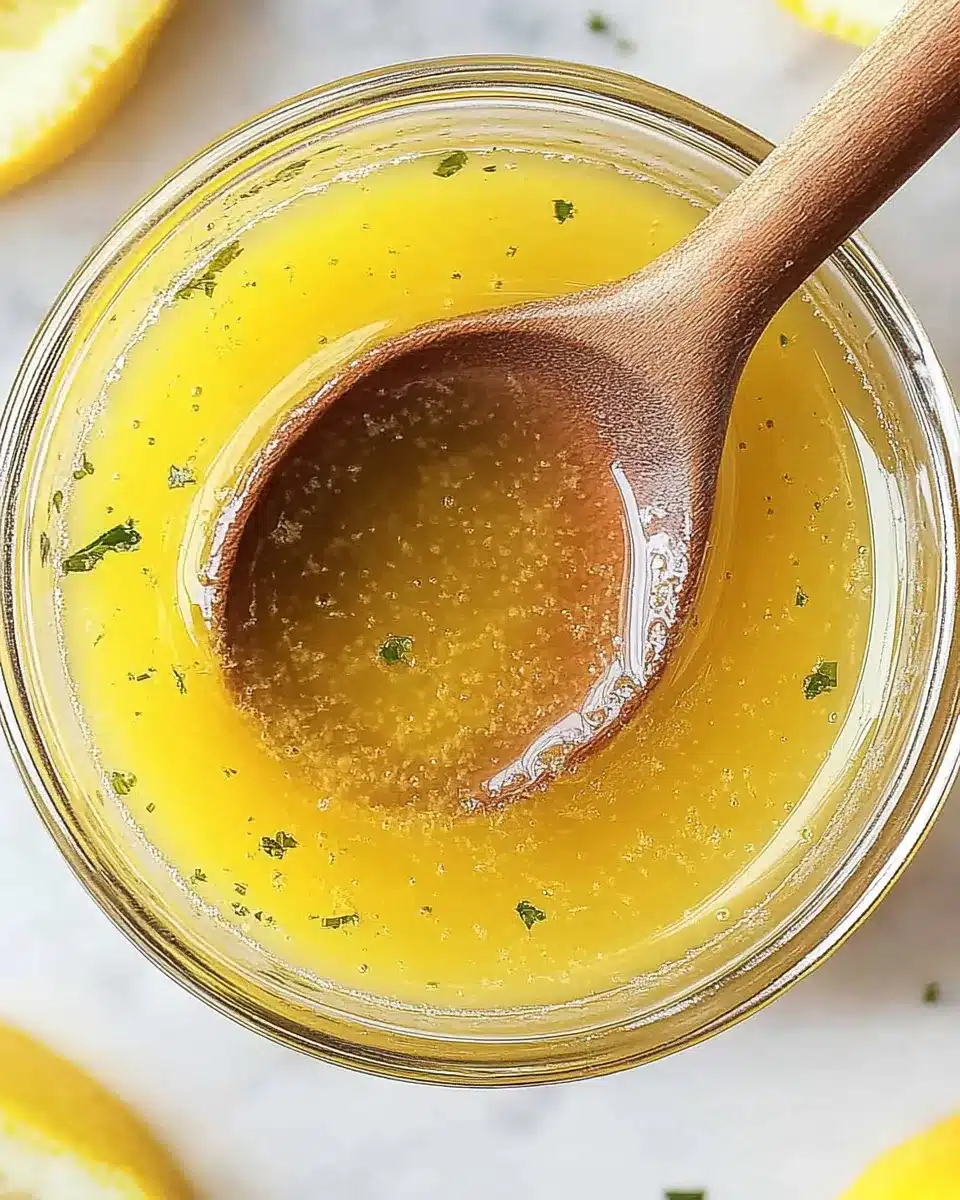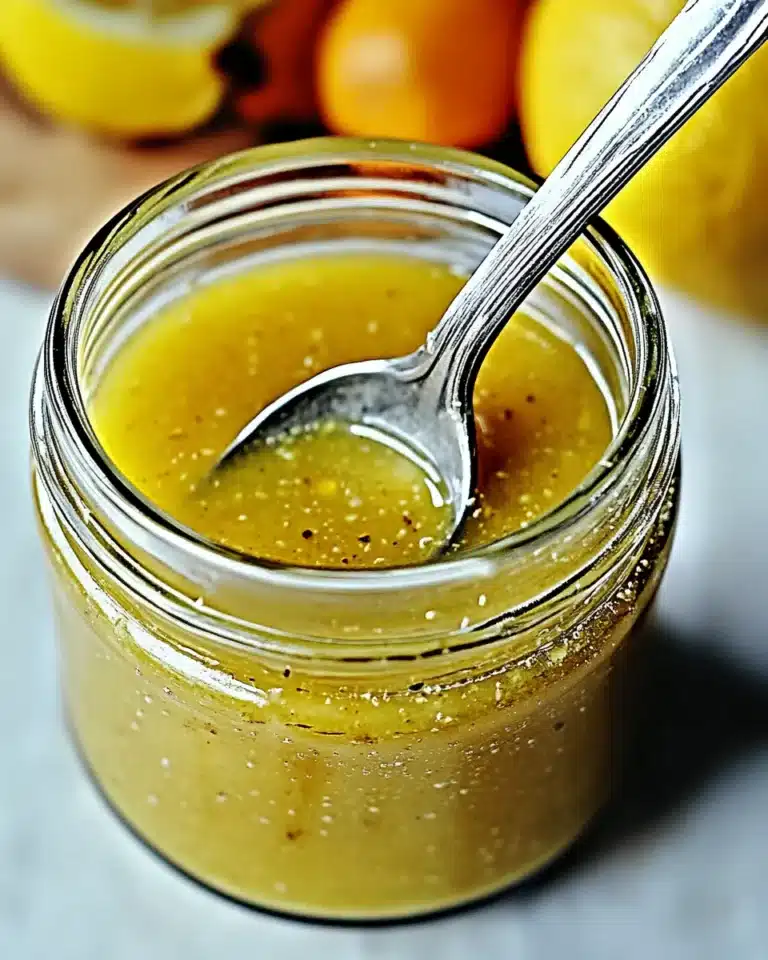Lemon Vinaigrette Dressing: Zesty & Refreshing Recipe

Imagine a burst of bright, zesty flavor that can elevate any dish—from crisp salads to grilled vegetables. That’s the magic of lemon vinaigrette dressing! It’s a versatile staple that delights your taste buds while adding a refreshing tang to your meals. Made simply with fresh lemons, quality olive oil, and a touch of seasoning, this dressing is not only easy to whip up but also a fantastic base for numerous variations. Want to spice it up? Consider incorporating herbs like basil or dill, or throw in a hint of honey for a touch of sweetness. For the perfect balance, remember to adjust the acidity and oil ratio to suit your palate.
Whether you’re drizzling it over greens or marinating chicken, preparing your dressing at home ensures a fresher flavor—and it’s a delightful way to showcase seasonal ingredients. Join me in crafting this citrusy delight and explore tips that will help you achieve the ideal dressing for every occasion!
Ingredients for Lemon Vinaigrette Dressing:
To prepare a refreshing and zesty lemon vinaigrette dressing that serves eight to ten people, gather the following ingredients:
Base Ingredients
- 1/2 cup fresh lemon juice (approximately 2 to 3 large lemons, juiced)
- 1 cup extra virgin olive oil
- 2 tablespoons Dijon mustard
- 2 tablespoons honey or maple syrup (for a vegan option)
Flavor Enhancers
- 1 clove garlic, finely minced (or pressed)
- 1 teaspoon lemon zest (grated from one of your zested lemons)
- 1/2 teaspoon sea salt (adjust to taste)
- 1/4 teaspoon freshly cracked black pepper (or to your liking)
Fresh Ingredients (Optional)
For those looking to add an extra burst of flavor or a unique twist to the dressing, consider incorporating one or more of the following:
- 1 tablespoon chopped fresh herbs (such as parsley, basil, or thyme)
- 1 teaspoon capers, rinsed and chopped for a briny kick
- 1 teaspoon finely chopped shallots for a milder onion flavor
- 1/2 teaspoon crushed red pepper flakes for a hint of heat
Storage and Serving Suggestions
The dressing can be made ahead of time and stored in an airtight container in the refrigerator for up to one week. Just give it a good shake or stir before serving as the ingredients may separate. Serve this delightful dressing over fresh greens, roasted vegetables, or even as a marinade for grilled meats or fish.
Feel free to mix and match the flavor enhancers to tailor the vinaigrette to your liking or the season. For instance, try adding some orange juice for a sweeter citrus note or a splash of balsamic vinegar for a tangy depth. The versatility of this dressing makes it an essential addition to your culinary repertoire.
How to prepare Lemon Vinaigrette Dressing:
Making a zesty Lemon Vinaigrette Dressing is easy and takes only a few minutes. Follow these simple steps for a fresh and vibrant dressing that will elevate your salads.
Gather Your Ingredients
Start by collecting all the necessary ingredients. You’ll need fresh lemons, extra-virgin olive oil, Dijon mustard, honey or maple syrup, salt, and pepper. Using fresh ingredients will enhance the flavor.
Squeeze the Lemons
Take your fresh lemons and cut them in half. Use a citrus juicer or reamer to extract the juice. Aim for about ¼ cup of fresh lemon juice, which will provide that essential tangy flavor.
Add the Dijon Mustard
In a mixing bowl, add 1 teaspoon of Dijon mustard to the lemon juice. This ingredient helps to emulsify the dressing and adds a nice kick.
Incorporate Sweetness
Add 1 teaspoon of honey or maple syrup to the mixture. This will balance the acidity of the lemon juice with a hint of sweetness. Adjust more or less according to your taste preference.
Mix in Salt and Pepper
Season the mixture with a pinch of salt and freshly cracked black pepper. Start with about ¼ teaspoon of each, as you can always adjust the seasoning later.
Whisk in the Olive Oil
Next, slowly drizzle in ½ cup of extra-virgin olive oil while whisking continuously. This step is crucial for creating a smooth and emulsified dressing. Keep whisking until all oil is blended well with the other ingredients.
Taste and Adjust
After combining everything, taste your dressing. Adjust the seasoning by adding more salt, pepper, or sweetness if needed. Ensure the flavors are balanced, bright, and delicious.
Store or Serve
If you’re not using the dressing immediately, transfer it to a clean jar with a lid. Refrigerate for up to one week. Don’t forget to shake well before each use, as the ingredients may separate when stored.
Enjoy Your Dressing!
Now that you have prepared your homemade Lemon Vinaigrette Dressing, drizzle it over your favorite salads, grilled vegetables, or even as a marinade for meats. Enjoy the freshness!
Tips for the Perfect Lemon Vinaigrette Dressing
Use Quality Ingredients
The flavors in your dressing come from the quality of each ingredient. Start with fresh lemons. The zest and juice from a just-picked lemon provide bright and zesty flavor. Extra virgin olive oil is your best choice for a frying flavorful base. Look for one that’s cold-pressed for the highest quality. Choose a vinegar that complements the lemon. A white wine or apple cider vinegar works well, adding depth without overpowering the citrus.
Maintain the Right Temperature
When making your vinaigrette, ensure each ingredient is at room temperature. This helps them emulsify better. Cold ingredients can cause the oil to solidify, making it hard to blend properly. If you’re working in a chilly kitchen, you can warm the olive oil slightly before mixing. Just make sure it’s not hot, as this can cook the lemon juice and alter the flavor.
Balance the Flavors Carefully
A great dressing strikes a balance between acidity and sweetness. While lemons provide tartness, you might need a pinch of sugar or honey to offset that bite, especially if the lemons are particularly sour. Taste as you go to find that perfect mix. You can also add a little Dijon mustard for an extra layer of flavor, which also aids in emulsification.
Creative Variations and Substitutions
You can easily customize this dressing to meet dietary needs. For a vegan option, skip the honey and use maple syrup or agave nectar for sweetness. If you’re sensitive to acidity, use a milder vinegar like rice vinegar or adjust the lemon juice by mixing in a bit of water.
For extra flavor, consider adding herbs like minced garlic, chopped fresh basil, or oregano. These can elevate your dressing, making it more versatile for various salads or marinades. If you want a creamier texture, whisk in a bit of Greek yogurt or a plant-based alternative.
Storage Tips for Your Vinaigrette
Store your vinaigrette in a sealed container in the refrigerator. It should stay fresh for about a week. Just remember to shake or stir it well before using, as the ingredients may separate. If you notice it thickened after cooling, bring it to room temperature and whisk or shake again for a smooth dressing.
Enjoy your delicious and versatile creation!
Storage Tips for Lemon Vinaigrette Dressing:
Keeping your Lemon Vinaigrette Dressing fresh and flavorful requires some simple storage practices. By following these guidelines, you can enjoy its zesty taste for weeks.
Refrigerate for Freshness
Always store your vinaigrette in the refrigerator. The cold temperature slows down the degradation of its ingredients, especially the lemon juice and herbs. Find an airtight container or a mason jar with a tight seal. This prevents air from entering and keeps your dressing tasting just as vibrant as when you first made it.
Check Your Ingredients
Use the freshest ingredients possible to make your dressing. Fresh lemons, quality olive oil, and recently ground spices help improve the shelf life of the vinaigrette. Avoid using old or expired components, as they will compromise both the taste and longevity.
Avoid Direct Sunlight
Keep the dressing away from direct sunlight and heat sources. Exposure to light and warmth can lead to faster spoilage, causing flavors to diminish. Store the vinaigrette in a dark cabinet or at the back of the fridge, where it is least affected by fluctuating temperatures.
Monitor Shelf Life
The typical shelf life of homemade vinaigrette is about one week when stored properly in the fridge. If you notice any change in color, texture, or smell, it’s best to discard it. Homemade versions usually don’t contain preservatives, so they won’t last as long as store-bought options.
Emulsification Is Key
When storing, remember that the ingredients may separate over time. This separation is normal; simply shake or stir before using. Doing this helps re-emulsify the mixture, adding back that fresh consistency you desire.
Freezing for Long-Term Storage
If you want to keep your vinaigrette for longer than a week, consider freezing it. Pour the dressing into an ice cube tray, and freeze it in portions. Once frozen, transfer the cubes into a freezer-safe bag. When you need a quick flavor boost, simply thaw the desired amount in the refrigerator. This method preserves the dressing for up to three months.
By implementing these storage tips, you can extend the life of your dressing while ensuring that it remains a delicious addition to your salads and dishes.
Related Recipes to Enhance Your Salad Experience
If you enjoy the refreshing zest of lemon vinaigrette, you may want to explore these complementary recipes. They harmonize beautifully with citrus flavors and elevate any salad or dish.
- Honey Mustard Dressing: Like lemon vinaigrette, honey mustard dressing balances acidity and sweetness. The tangy mustard pairs well with greens and adds a new layer of flavor that brightens up salads. Use it on roasted vegetables for an extra kick!
- Balsamic Vinaigrette: This dressing showcases rich, robust flavors that can stand up to heartier salads or grilled meats. The sweet and tart notes in balsamic vinegar complement lemony flavors, making it a perfect match for dishes featuring berries or nuts.
- Greek Yogurt Dressing: For a creamy alternative that still captures that fresh zing, try Greek yogurt dressing. This option is healthier and offers a smooth texture that contrasts nicely with crisp veggies. Add herbs like dill or parsley for added freshness!
- Avocado Lime Dressing: Avocado brings a creamy richness, while lime juice keeps the dressing zesty. It pairs beautifully with Southwestern salads or grain bowls and can be drizzled over taco dishes as well.
- Thai Peanut Dressing: Incorporating a hint of sweetness and spice, this dressing adds a unique twist. It works wonderfully for Asian-inspired salads or to marinate chicken. The peanut flavor complements citrus offerings and creates a delightful taste journey.
Each of these recipes contributes a unique flavor profile while sharing similarities with the original dressing. Try them out to diversify your culinary creations!
Frequently Asked Questions:
What is Lemon Vinaigrette Dressing made of?
Lemon vinaigrette is a simple yet flavorful dressing that typically includes fresh lemon juice, olive oil, Dijon mustard, salt, and pepper. Some variation may include additional ingredients like honey for sweetness, garlic for depth, or fresh herbs to elevate its flavor profile. The combination yields a bright and tangy dressing that pairs perfectly with salads, grilled vegetables, or even as a marinade for meat.
How do you make Lemon Vinaigrette Dressing from scratch?
Creating your own lemon vinaigrette is incredibly straightforward. Start by whisking together fresh lemon juice with olive oil in a small bowl or jar. For a more complex flavor, consider adding a spoonful of Dijon mustard, salt, and freshly ground pepper. Adjust the ratio of oil to lemon juice depending on your taste preference; a general rule is three parts oil to one part acid (in this case, lemon juice). Shake or whisk until well combined, and it’s ready to use!
How long does homemade Lemon Vinaigrette Dressing last?
When prepared and stored in an airtight container, homemade lemon vinaigrette can be kept in the refrigerator for about one week. As the ingredients marry, the flavors may intensify. However, be mindful of the freshness of your ingredients, especially the lemon juice. If you notice any changes in smell or appearance, it’s best to discard it.
Can I add ingredients to my Lemon Vinaigrette Dressing?
Absolutely! One of the great things about lemon vinaigrette is its versatility. You can enhance it by incorporating various ingredients such as minced shallots, garlic, or fresh herbs like basil and parsley. You may also experiment with different oils, such as avocado or walnut oil, to create unique flavor variations.
Is Lemon Vinaigrette Dressing healthy?
Yes, lemon vinaigrette can be a healthy option, especially when made with quality ingredients. Olive oil is rich in healthy fats and antioxidants, while fresh lemon juice offers vitamin C and aids digestion. This dressing is a great way to enhance the flavors of your dishes without excessive calories or unhealthy additives. Just watch the portion size as with any dressing.
What dishes pair well with Lemon Vinaigrette Dressing?
Lemon vinaigrette dressing is incredibly versatile and pairs wonderfully with various dishes. It is perfect for drizzling over fresh salads, grilled vegetables, or roasted chicken. Additionally, it can serve as a zesty marinade for fish or a vibrant topping for grains like quinoa and farro. Its bright flavor can elevate nearly any dish!
Conclusion:
In summary, Lemon Vinaigrette Dressing is an incredibly versatile and straightforward recipe that enhances a variety of dishes. Its refreshing acidity and bright flavor make it the perfect companion for salads, grilled vegetables, and marinades. Remember, the beauty of this dressing lies in its flexibility; you can easily adjust the ingredients to suit your taste preferences—adding herbs for depth or a hint of sweetness with honey. Customization is key, whether you prefer a zesty kick or a milder touch. With just a few simple ingredients, you can whip up a delicious dressing that elevates any meal. Experiment with different oils and acids to discover your favorite blend. With these tips in mind, you’ll create a delightful Lemon Vinaigrette Dressing that reflects your unique culinary style and excites your taste buds. Enjoy the process and have fun with it!







